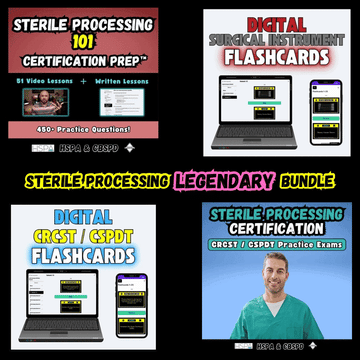Transporting Dirty Surgical Instruments

When transporting dirty surgical instruments from the point of use to the sterile processing area, there are several important considerations to ensure safety and effective handling. These considerations apply to any surgical instruments used within the facility, as well as those being transported from outside clinics or entities that use the Central Sterile Processing department for cleaning and sterilization. Here are five key things to keep in mind:
Containment and Segregation:
Leakage Prevention:
- Containers and/or carts used to transport dirty instrumentation must be leak/spill proof. All fluids must be able to be contained inside without the ability to leak during the transport process.
Identification and Documentation:
- Clearly label and identify the containers or trays containing the dirty instruments with appropriate tags or labels. Include necessary information such as the date, time, and location of collection, as well as any relevant patient or procedure details. Accurate documentation helps in tracking the instruments, maintaining accountability, and facilitating proper processing.
Safe Handling and Ergonomics:
- When transporting dirty instruments, prioritize the safety and well-being of healthcare workers. Ensure that they have access to personal protective equipment (PPE) such as gloves and possibly protective eyewear, as needed. Promote proper lifting and ergonomics techniques to prevent injuries during the handling and transportation process.
Prompt Transport:
- Timely transport of dirty instruments to the sterile processing area is essential to minimize the risk of contamination and maintain the integrity of the instruments. Establish clear protocols and procedures for pre-treating dirty surgical instruments and transporting those dirty instruments, ensuring that dedicated personnel are responsible for this task. Failure to maintain appropriate moisture on dirty instruments may cause bioburden to dry and harden making the cleaning process timely and unnecessary. Using sterile water to soak a towel and lay over the dirty instruments, or a pre-enzymatic gel or foam will keep the instruments moist, and begin the breakdown process of blood and bioburden. Avoid unnecessary delays and promptly deliver the instruments to the designated processing area.
It is important to note that these recommendations should be considered in conjunction with any local or facility-specific guidelines and regulations. Adhering to proper protocols for transportation helps maintain the safety of healthcare workers, preserves the quality of the instruments, and ensures the effective processing and sterilization of surgical instruments for subsequent use. If any of the above considerations are not being followed in your facility, consider bringing this information back to your leadership for discussion to see if it would be beneficial for your department.
Share
Let customers speak for us
from 241 reviewsI took the practice test and I got a 91% on my certification exam!!
This course was the extra boost that I needed in order be confident in passing the exam. Thank you for all the information provided. I even refer to your notes while working.
Very helpful to me I can study any where at my own pace and low cost than going to school...I'm glad that there is something like this online to help anyone who want to pursue their career as a sterile processing tech.
I loved it, it’s very informative and the questions are great, it’s a great resource to purchase if you want to prepare for your certification exam!
I’ve really enjoyed this course so far. It delivers the information in a straightforward, digestible way. The Sterile Guy has compiled a highly effective program. Thanks very much from one highly satisfied customer!
The practice exams are detailed and easy to navigate. Brandon continues to show his passion in this industry by sharing his knowledge with up-and-coming techs. I also recommend investing in his flashcards. It has helped me greatly. Thank you, Brandon!,
These practice quizzes really helped me get the hang of answering questions related to instruments and the processes of preparing them! I even bought them twice cause I ran out of time lol. Super helpful!
I recently completed the Sterile Processing Guy course online and was extremely impressed. The content was clear, well-organized, and easy to follow. It helped me better understand important concepts like decontamination, disinfection, and sterilization. I appreciated how practical and informative the lessons were, it definitely made studying for certification feel more manageable. I highly recommend this course to anyone pursuing a career in sterile processing!
I won’t lie, I failed the first time around. So I decided to buy this practice test and I passed with flying colors my second go. Highly recommend to anyone interested in the CER, it helped a lot!
The flash card quality is amazing! Bravo sir! The card quality is way above average, questions are great! I’m still learning, utilizing these cards and your practice tests. Thanks for all the info!
I passed the CRCST exam. Taking reg sterile guy practice test over and over definitely helped get the job done.
This certification prep course is a must. Great videos with a lot of information and plenty of of practice exams.
These flashcards are so helpful and well put together. Highly recommend!
I'm really happy that I purchased the SP practice exam. I love how if you answer the question incorrectly, the correct answer will include the page number of the text book to find the answer. The questions are literally based on the textbook. I suggested "The Sterile Processing Guy" to my friend that is studying for the exam as well.








